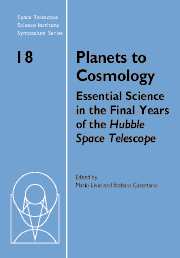 Planets to Cosmology
Planets to Cosmology Book contents
- Frontmatter
- Contents
- Participants
- Preface
- Hubble's view of transiting planets
- Unsolved problems in star formation
- Star formation in clusters
- HST abundance studies of low metallicity stars
- Physical conditions and feedback: HST studies of intense star-forming environments
- Quasar hosts: Growing up with monstrous middles
- Reverberation mapping of active galactic nuclei
- Feedback at high redshift
- The baryon content of the local intergalactic medium
- Hot baryons in supercluster filaments
- Galaxy assembly
- Probing the reionization history of the Universe
- Studying distant infrared-luminous galaxies with Spitzer and Hubble
- Galaxies at z ≈ 6–i′-drop selection and the GLARE Project
- The Hubble Ultra Deep Field with NICMOS
HST abundance studies of low metallicity stars
Published online by Cambridge University Press: 17 August 2009
- Frontmatter
- Contents
- Participants
- Preface
- Hubble's view of transiting planets
- Unsolved problems in star formation
- Star formation in clusters
- HST abundance studies of low metallicity stars
- Physical conditions and feedback: HST studies of intense star-forming environments
- Quasar hosts: Growing up with monstrous middles
- Reverberation mapping of active galactic nuclei
- Feedback at high redshift
- The baryon content of the local intergalactic medium
- Hot baryons in supercluster filaments
- Galaxy assembly
- Probing the reionization history of the Universe
- Studying distant infrared-luminous galaxies with Spitzer and Hubble
- Galaxies at z ≈ 6–i′-drop selection and the GLARE Project
- The Hubble Ultra Deep Field with NICMOS
Summary
Introduction
Abundance studies of the oldest stars provide critical clues to—and constraints upon—the characteristics of the earliest stellar populations in our Galaxy. Such constraints include those upon: light element production and BBN; the early star-formation and nucleosynthesis history of the Galaxy; the characteristics of heavy-element nucleosynthesis mechanisms; and the ages of early stellar populations from nuclear chronometers. Discussions of many of these issues are to be found in a number of review papers (Wheeler et al. 1989; McWilliam 1997; Truran et al. 2002; Gratton, Sneden, & Caretta 2004).
While much of the available data has been obtained with ground-based telescopes, there is much to learn with HST. Studies in the wavelength region accessible with HST can, in fact, address issues ranging from the origin of the light elements Li, Be, and B to the production mechanisms responsible for the synthesis of the heaviest elements through thorium and uranium. In the following two sections, we will review specifically first boron abundance studies at low Z and then abundances of the heavy elements Ge, Zr, Os, Pt, Au, and Pb, at low Z.
Boron abundances in halo stars
Knowledge of lithium, beryllium, and boron abundances in stars play a major role in our understanding of Big Bang nucleosynthesis, cosmic-ray physics, and stellar interiors.
In the standard model for the origin and evolution of the light elements, only 7Li is produced in significant amounts from Big Bang (primordial) nucleosynthesis.
- Type
- Chapter
- Information
- Planets to CosmologyEssential Science in the Final Years of the Hubble Space Telescope: Proceedings of the Space Telescope Science Institute Symposium, Held in Baltimore, Maryland May 3–6, 2004, pp. 57 - 62Publisher: Cambridge University PressPrint publication year: 2006


